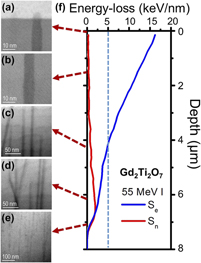Crossref Citations
This article has been cited by the following publications. This list is generated based on data provided by
Crossref.
Mostaed, Ali
Balakrishnan, Geetha
Lees, Martin R.
and
Beanland, Richard
2018.
Electron-irradiation induced defects in Yb2Ti2.05O7.
Acta Materialia,
Vol. 143,
Issue. ,
p.
291.
Sachan, Ritesh
Ullah, Mohammad W.
Chisholm, Matthew F.
Liu, Jie
Zhai, Pengfei
Schauries, Daniel
Kluth, Patrick
Trautman, Christina
Bei, Hongbin
Weber, William J.
and
Zhang, Yanwen
2018.
Radiation-induced extreme elastic and inelastic interactions in concentrated solid solutions.
Materials & Design,
Vol. 150,
Issue. ,
p.
1.
Sachan, Ritesh
Zarkadoula, Eva
Ou, Xin
Trautmann, Christina
Zhang, Yanwen
Chisholm, Matthew F.
and
Weber, William J.
2018.
Sculpting Nanoscale Functional Channels in Complex Oxides Using Energetic Ions and Electrons.
ACS Applied Materials & Interfaces,
Vol. 10,
Issue. 19,
p.
16731.
Dukenbayev, K.
Kozlovskiy, A.
Korolkov, I.
and
Zdorovets, M.
2019.
Investigation of radiation resistance of AlN ceramics.
Vacuum,
Vol. 159,
Issue. ,
p.
144.
Sachan, Ritesh
Chisholm, Matthew F.
Ou, Xin
Zhang, Yanwen
and
Weber, William J.
2019.
Energetic Ion Irradiation-Induced Disordered Nanochannels for Fast Ion Conduction.
JOM,
Vol. 71,
Issue. 1,
p.
103.
Zhai, Pengfei
Nan, Shuai
Xu, Lijun
Li, Weixing
Li, Zongzhen
Hu, Peipei
Zeng, Jian
Zhang, Shengxia
Sun, Youmei
and
Liu, Jie
2019.
Fine structure of swift heavy ion track in rutile TiO2.
Nuclear Instruments and Methods in Physics Research Section B: Beam Interactions with Materials and Atoms,
Vol. 457,
Issue. ,
p.
72.
O'Quinn, Eric C.
Tracy, Cameron L.
Cureton, William F.
Sachan, Ritesh
Neuefeind, Joerg C.
Trautmann, Christina
and
Lang, Maik K.
2021.
Multi-scale investigation of heterogeneous swift heavy ion tracks in stannate pyrochlore.
Journal of Materials Chemistry A,
Vol. 9,
Issue. 31,
p.
16982.
Wardini, Jenna L.
Vahidi, Hasti
Guo, Huiming
and
Bowman, William J.
2021.
Probing Multiscale Disorder in Pyrochlore and Related Complex Oxides in the Transmission Electron Microscope: A Review.
Frontiers in Chemistry,
Vol. 9,
Issue. ,
Gupta, Ashish Kumar
Gupta, Siddharth
and
Sachan, Ritesh
2022.
Laser Irradiation Induced Atomic Structure Modifications in Strontium Titanate.
JOM,
Vol. 74,
Issue. 1,
p.
143.
Lan, Jianxiong
Zhai, Pengfei
Nan, Shuai
Xu, Lijun
Niu, Jingjing
Tian, Cheng
Li, Zongzhen
Li, Weixing
Liu, Jie
and
Ewing, Rodney Charles
2022.
Phase stability of pre‐irradiated CeO2 with swift heavy ions under high pressure up to 45 GPa.
Journal of the American Ceramic Society,
Vol. 105,
Issue. 4,
p.
2889.
Gupta, Ashish Kumar
Gupta, Siddharth
Mandal, Soumya
and
Sachan, Ritesh
2022.
Laser Irradiation-Induced Nanoscale Surface Transformations in Strontium Titanate.
Crystals,
Vol. 12,
Issue. 5,
p.
624.
Ibrayeva, Anel
Mutali, Alisher
O'Connell, Jacques
van Vuuren, Arno Janse
Korneeva, Ekaterina
Sohatsky, Alexander
Rymzhanov, Ruslan
Skuratov, Vladimir
Alekseeva, Liudmila
and
Ivanov, Igor
2022.
Swift heavy ion tracks in nanocrystalline Y4Al2O9.
Nuclear Materials and Energy,
Vol. 30,
Issue. ,
p.
101106.
Xu, Lijun
Rymzhanov, Ruslan A.
Zhai, Pengfei
Zhang, Shengxia
Hu, Peipei
Meng, Xuan
Zeng, Jian
Sun, Youmei
and
Liu, Jie
2023.
Direct Fabrication of Sub-10 nm Nanopores in WO3 Nanosheets Using Single Swift Heavy Ions.
Nano Letters,
Vol. 23,
Issue. 10,
p.
4502.
Gupta, Ashish Kumar
Zarkadoula, Eva
Ziatdinov, Maxim
Kalinin, Sergei V.
Paduri, Vikas Reddy
Hachtel, Jordan A.
Zhang, Yanwen
Trautmann, Christina
Weber, William J.
and
Sachan, Ritesh
2024.
Nanoscale core–shell structure and recrystallization of swift heavy ion tracks in SrTiO3.
Nanoscale,
Vol. 16,
Issue. 30,
p.
14366.
